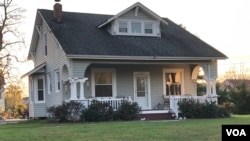For decades, many Americans have viewed owning their own home as a tangible symbol of the American Dream. But the question of whether that dream includes dividing one single-family home into two — along with other higher housing density options — is about to be tested in a handful of states nationwide.
Virginia is one of the latest states to tackle the affordable housing crisis by considering zoning rules to allow denser — and, potentially, more affordable — housing, in any area now zoned for single-family homes.
“If a property owner feels it fits their need to upgrade to a duplex from a single family's owned property, then they will go about it through a local approval process,” says House Delegate Ibraheem Samirah, who represents a district in suburban Washington, D.C. “After the local approval process is completed, then they can create their two families’ owned property as they see fit.”
Samirah introduced a bill to allow duplex homes, like townhouses and cottages, in any place that’s currently zoned for single-family homes. The specifics of what those multi-family properties would look like will be left to local governments. The bill does not ban single-family homes.
It’s the kind of move toward creating more affordable housing that’s already been introduced on the West Coast of the United States. Oregon was the first state in the country to ban restrictive single-family zoning in July 2019.
Planning experts and local officials say suburban sprawl has negative impacts on the environment, puts a heavier burden on local services, isolates people, and excludes lower income households and households with people of color from certain communities through economic means.
A 2019 Harvard housing report found a “relative lack of smaller, more affordable new homes.” The same report finds that about half of all renter households nationwide spend almost one-third of their income on housing.
But the move away from single-family zoning won’t be an easy one.
“At some level, that development pattern is really uniquely American,” says Robert Parker, executive director of the Institute for Policy Research and Engagement at the University of Oregon.
“People who have lived, and grew up, in low-density suburban developments have a strong preference for that. They can't really envision a future that's substantially different than that.”
The size of the average house has more than doubled since the 1950s. In 2019, the average size of a new single-family home was 240 square meters (2,584 square feet), according to the National Association of Homebuilders.
Americans clearly like their space. But millennials — people in their mid-20s to late 30s who make up the nation’s largest living generation — have their own ideas about what the ideal home looks like, according to a Portland, Oregon-area survey cited by Parker.
“Eighty percent of them would prefer to live in a detached, single-family residence, and so it really begins to become a matter of scale and amenity,” Parker says. “A lot of those those younger households are really looking for smaller units in walkable neighborhoods and, increasingly, the development community is beginning to recognize that and thinking about ways that they can build those environments.”
Samirah, the Virginia delegate, expects some pushback from people who are worried their neighborhoods could become less desirable, but he says correctly organizing density can benefit property owners, including those who are struggling financially.
“People think it's going to be a major shift in the landscape of suburbia. I think that’s a false narrative,” Samirah says. “This is a great way for (homeowners) to rent out their basement, or rent out half their house, or whatever it may be...If you're thinking of retiring, instead of selling your house and moving out to another area, it also helps them keep their families in place.”
“You can have a mixture of densities that's not detrimental to set of lifestyles that people hold very dear, that will allow housing choice for households that are struggling to find housing that's affordable to them in environments that are conducive to the lifestyles that they would like to lead,” Parker says.
He adds that the suburban way of life isn’t going anywhere in the near future. “There's little that we can do to retrofit suburbia moving forward so that land use pattern is pretty well ingrained and it's going to be there for generations.”




